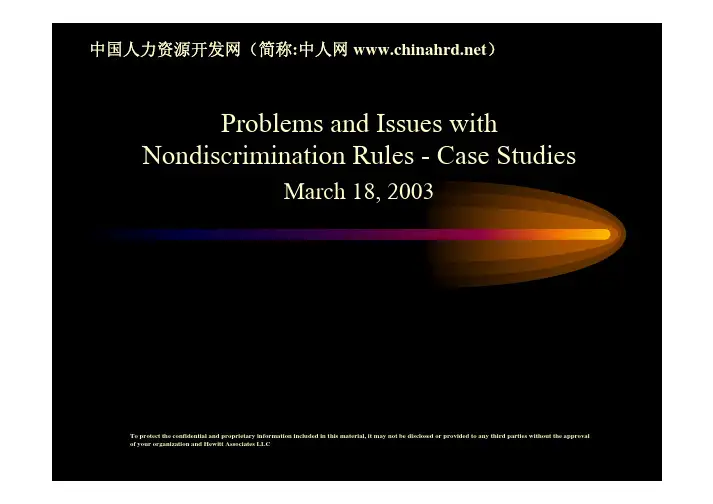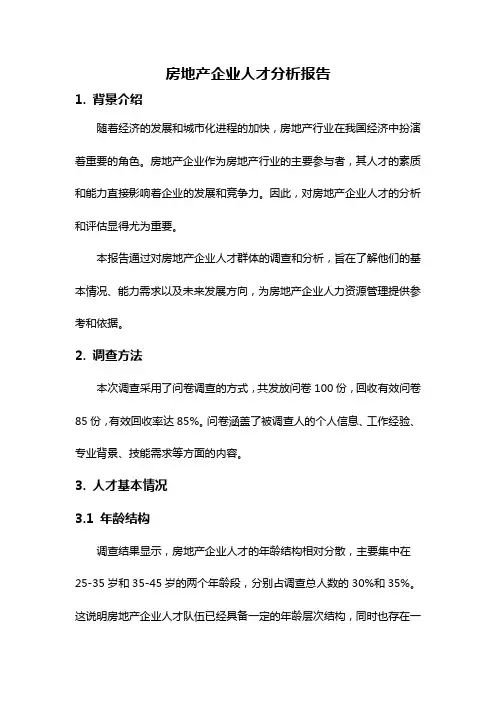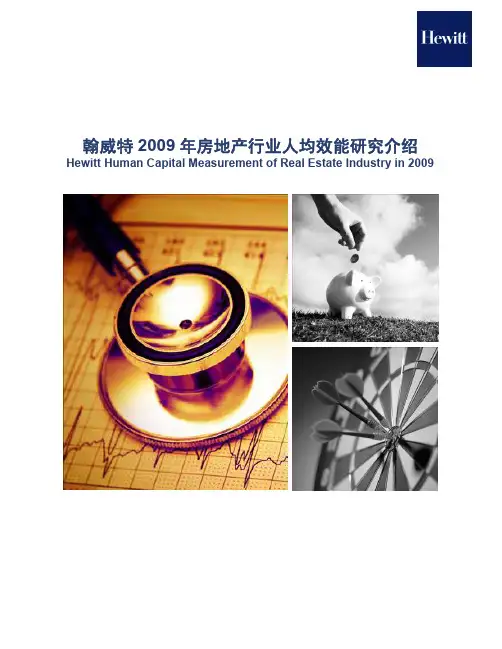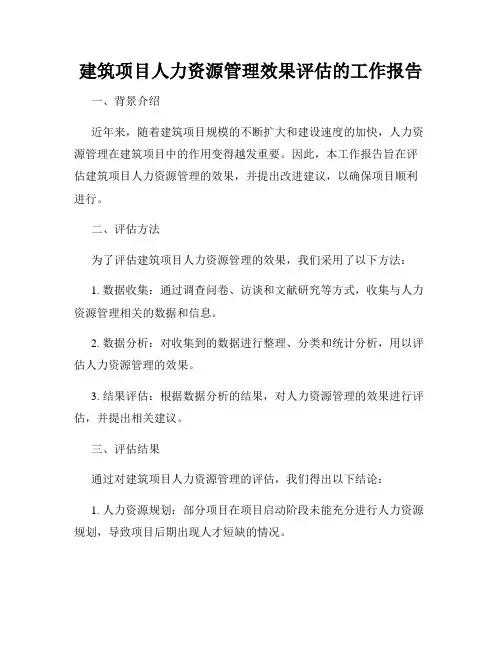翰威特房地产行业人力资本评估报告l
- 格式:pdf
- 大小:420.62 KB
- 文档页数:43



中国人力资源开发网(简称:中人网 )Problems and Issues with Nondiscrimination Rules - Case StudiesMarch 18, 2003To protect the confidential and proprietary information included in this material, it may not be disclosed or provided to any third parties without the approval of your organization and Hewitt Associates LLC中国人力资源开发网(简称:中人网 )Agenda• • • • Controlled Group Issues Plan Aggregation Issues Determination of HCEs Determination of Most Valuable Accrual Rates中国人力资源开发网(简称:中人网 )Controlled Group Issues中国人力资源开发网(简称:中人网 )Groups to Include• Who knows the group? • Are there leased employees? • Are there affiliated service group relations? • Are there acquisitions?中国人力资源开发网(简称:中人网 )Issue 1: Who knows the controlled group?Essential to involve legal counsel• HR contacts may not know– – – – whether or not they have a parent or sub percentage of ownership if they do that foreign parent owns other U.S. companies whether business relationships constitute an affiliated service group or leasing arrangement• Requires interpretations of corporate law • WE DO NOT PRACTICE LAW中国人力资源开发网(简称:中人网 )Issue 1: Who knows the controlled group?AAcquires 80% USA USA France 0%-Svcs onlyKJUSAB80% USA0%-Mgt Svcs only100%H50%Canada 50%C40%-acquired prior yearD40%USA 85%IUSA0%-Leasing grp FranceUSAEFUSAGExercise: Identify controlled groups in years 0, 1, and 2, assuming acquisitions admitted to controlled group at end of transition period中国人力资源开发网(简称:中人网 )Issue 1: Who knows the controlled group?Situation: Company with foreign ownership• Family, Inc. family company owner retiring • Sells to New Dad, Inc., a large European company so children don’t take over • Family, Inc. checks and finds other US companies owned by New Dad to include in testing • Later Family, Inc. finds that New Dad’s Canadian subsidiary also owns additional US entities to include in testing, but wonders about finding others中国人力资源开发网(简称:中人网 )Issue 1: Who knows the controlled group?Situation: Holding company• All Alone Company is acquired by a holding company (Hold My Hand But Pretend I’m Not Here, Inc.) • All Alone is happy it still gets to maintain its own plans, payroll, do its own filings • But, now All Alone must figure out who else Hold My Hand owns and how to collect data from who in order to do its testing中国人力资源开发网(简称:中人网 )Issue 2: Are there leased employees?Leasing arrangements• Considered leased employee if– – – – provide services pursuant to an agreement services performed substantially full time for at least a year services provided under direction of recipient employer not covered by a safe harbor retirement plan中国人力资源开发网(简称:中人网 )Issue 2: Are there leased employees?Situation: Typical leasing arrangements• In NDT planning meeting, Who Me, Lease? Co. states they have only 3 leased employees– jokes passing a small group in the hall that we had just passed all their leased employees• After reviewing a leased employee checklist, Who Me Lease calls back with 200 leased employees– since the controlled group had only 2000 NHCEs before, the 75% ratio test changes to 68% and now requires an average benefit percentage testAre there leased employees?Situation: Company employees work at JV •Division J is owned by Bigger Fish Company •Bigger Fish Company spins off Division J to form a joint venture•Division J employees become employees of the JV •Bigger Fish Company also has a few employees who remain Big Fish, but work at the JV–these employees are tested as employees by Bigger Fish,but also must be included as leased employees by the JVAre there leased employees?Situation: Company acquires employees•We Do Everything, Inc. acquires the office staff, their portion of the retirement plan, and the whole building of the We Don’t Do Floors Co.•The professional staff of We Don’t continues to work in the building & control the work of the office staff •We Do tests the office staff as employees•We Don’t includes the office staff as leased –aggregates office plan as if its ownAre there affiliated service groups?Affiliated Service Groups•No ownership involved, based in part on regularprovision of services or management services by a service organization•Don’t forget affiliated service groups of affiliatedservice groups•IRS will rule via Form 5300 filing whether anaffiliated service group relationship existsAre there affiliated service groups?Situation: Company acquires employees -2•We Do Windows, Inc. acquires the office staff, theirportion of the retirement plan, and the whole building of the We Don’t Do Windows Co.•The professional staff of We Don’t continues to work in the building & control the work of the office staff •An affiliated service group relationship exists•We Do and We Don’t are tested as one controlledgroupAre there affiliated service groups?Situation: Attorneys disagree•We Do Everything, Inc. now acquires We DoWindows, Inc.•The affiliated service group relationship is causing its plan to fail under the new controlled group•The attorney for We Do Windows thinks it shouldpass since they feel the relationship with We Don’tDo Floors should also be an affiliated service group •The attorney for We Do Everything disagreesWhat about acquisitions?Transition rule application•Not much guidance•Generally agreed the transition rule can’t be relied on to avoid testing indefinitely if frequent M&A–some attorneys suggest testing the company and itsacquisition as separate controlled groups until the end ofthe transition period–some suggest testing the company only without itsacquisition until the end of the transition period–some ignore the transition ruleWhat about acquisitions?Situation: Separate testing during transition •All Together Now, Inc. acquires Not Quite Together Yet, Inc. and instructs Not Quite Together to continue testing as usual until transition ends•Not Quite Together tests its multiple employer plan –plan provides cuts to HCEs•After transition, All Together Now attorney gets involved in testing and determines there is a single employer, not multiple employers中国人力资源开发网(简称:中人网)Groups to Exclude•Are there multipleemployer plans?•Are there jointventures?•What about the tax-exempt exclusion?Any multiple employer plans?Multiple employer plans•Each employer adopting a multiple employer plan must test separately from other adopting employers •However, failing results for one adopting employer affect the qualified status of all in the planAny multiple employer plans?Situation: Plan has adopting employers •Wild Blue Company sponsors a profit sharing plan and Limp a Lot, Inc. and Come Fly With Me, Inc. also choose to adopt the plan.•Come Fly uses the “top 20%”election for HCEs. •Limp a Lot dissolves, but Come Fly hires many of the Limp a Lot employees.•Come Fly includes its new employees for testing, but ignores them for HCE determination.Any multiple employer plans?Situation: Continues benefits after sale •Wild Blue Company sells its Flap Your Wings division, but allows the employees to continue in its plans for one year.•The new Flap Your Wings Company becomes another adopting employer for the year.–The Wild Blue Company will test including Flap YourWings employees/benefits up to sale–Flap Your Wings will do its own testing of the plan fromthe sale date until benefits ceaseWhat happens with JVs?Joint Ventures•When there is not an 80% ownership relationship for a joint venture, each group becomes a separate controlled group•As stated previously, there may be some employees included in testing for both, as a leased employee in one entityWhat happens with JVs?Situation: Continues benefits after JV•You Complete Me, Inc. and Ditto, Inc. each spin off divisions to form a joint venture.•The employees from each company remain in their respective plans and the JV becomes an adopting employer of both plans.•Neither plan passes testing with respect to the JVWhat about tax-exempt exclusions?Tax-exempt exclusion•Only allowed for 401(k) plan testing •Requires no tax-exempt employees benefiting in401(k)•Requires 95% coverage of non tax-exemptemployees in the 401(k) plan•If requirements met, 401(k) plan testing for 410(b) can exclude tax-exempts from the controlled groupWhat about tax-exempt exclusions?Situation: For Profits have own 401(k) plans •You Keep It Company is “not for profit”andacquires We’ll Take It, Corp., a “for profit”company •Smaller We’ll Take It has four divisions, each withits own 401(k) plan•Even aggregated, 401(k) plans fail 410(b)–no other employees left to offer 401(k) to improve results •No division’s 401(k) plan covers 95% of We’ll Take It employees to exclude tax-exempts中国人力资源开发网(简称:中人网)When to Aggregate PlansCan’t Pass NCT?Situation: Two plans with different BRFs •Company has two plans with identical formulas •One plan is discriminatory alone, so desires to aggregate with second plan•BRFs are different, but the second plan’s BRFs are more generous, so can be aggregated with first plan’s BRFs to pass•Frequent requests to improve first plan benefits and BRFs are monitored to ensure testing complianceCan’t Pass NCT?Situation: Plans amended to be identical •We Are All Individuals, Inc. has a discriminatory plan•The plan aggregates with a second plan•First plan requires cuts to HCEs to ensure passing and can eliminate 401(a)(4) cuts if aggregated plan is safe harbor•First plan won’t give up accruals for terminations, and company insists on last-day for second planAggregating to Avoid ABT?Situation:Aggregating DB and DC?Situation: DB/DC plan can’t pass gateways •PS plan for Over There division employees and defined benefit plan for Over Here division•Over There PS provides 6% to rank and file, 3% to executives (rank and file includes some HCEs)•Over Here is a discriminatory group providing defined benefit plan with 1% of pay formula •Highest HCE allocation is a DB participant with 38%•Average NHCE rate for DB is 2.5%Aggregating DB and DC?Situation: DB/DC plan can’t pass gateways •DB/DC plan fails Minimum Allocation Gateway –1/3 of 38% > 2.5%–2.5% < 7.5%•DB/DC plan fails Primarily DB Gateway–DB group couldn’t pass NCT, so won’t have 50% NHCEs •DB/DC plan fails Broadly Available Separate Plans –if DB group could pass the NCT, there would be no reason to aggregateAggregating DB and DC?Situation: DB/DC plan can’t pass gateways •Consider implications under proposed cash balance regulations if DB plan converted to a cash balance plan with 6%/3% allocations as in PS, but–provided DB/CB choice to all in DB plan–provided “greater of”formula to all in DB plan–provided CB with frozen DB minimum to all in DB planAggregating vs. Merger?Situation: Merger of target plan and MPP •Safe harbor target plan participation was frozen several years ago•All employees hired since then participate in a safe harbor money purchase plan•To save money, trusts were combined, plans merged •Target and MPP tested by restructuring•…until cross-testing regulations–now is supposed to pass Gateways without restructureDifferent plan years in ABT?Situation: One employee, two plan years •Not really an aggregation issue•Employee benefits in a calendar year 401(k) plan and in a 4/1 plan year MPP plan•Employee is HCE for 2003 testing of the 401(k) plan •No testing done for the MPP since no HCEs benefit –would have been NHCE for plan year ending 3/31/2003•Average benefit test required for 401(k) plan中国人力资源开发网(简称:中人网)Determining HCEsAcquiring HCEs?Situation: New member of controlled group •BuyCo acquires NewCo assets on November 1, 2002•NewCo employees immediately join BuyCo’s DB plan•As part of transaction, certain senior NewCo execs will lose their jobs in early 2003•Can the BuyCo DB plan provide the execs with annual normal retirement pensions equal $16,000?Collecting the right pay?Situation: Average benefits test with different plan years•Plan A is being tested for its 12/31/2002 plan year •Plan B (10/31 pye) is also in the testing group •HCEs for the ABT are either Plan A (12/31/2002) or Plan B (10/31/2002) HCEs•Does Plan A keep track of fiscal 10/31 employee compensation? Or Plan B 12/31?When are snapshots not enough?Situation: Required to cross-test a defined contribution plan•Minimum allocation gateway requires each NHCE to receive an allocation at least 1/3 of the largest HCE allocation•The highest allocation rate is likely to belong to an HCE with partial year of pay•Snapshot testing identifies HCEs on the snapshot date, so could miss HCEs who leave mid-year中国人力资源开发网(简称:中人网)Determining Most ValuableAccrual Rates中国人力资源开发网(简称:中人网)Issue 1: Don’t forget to close windowsSituation: Plan offers an early retirementwindow•Window benefits are reflected in most valuableaccrual rates in first year it is open•In MVAR iteration, include window benefits at first age, but exclude them at ages after window closesWhat is average annual comp?Situation: Short-service employees•The regulations state that the averaging period must consist of three or more years, but need not be longer than the employee’s period of employment•They have less than a full averaging period of compensation•Can the rest of the averaging period be filled with zero compensation?Improving the rate groupingSituation: Not all rate groups pass 410(b)•Most often, rate group ranges are determined mechanically, starting at 0%•Frequently, better results are had by adjusting the starting point•The HCE rates within a range cannot be significantly higher than the nHCE rates中国人力资源开发网(简称:中人网)Odds and EndsUnion membershipSituation: Union and non-union members covered by same plan•Employer believes entire plan is collectively bargained•Identity of union members not always clear •Actuary has entire census, but no union indicator nor plan year compensationNon-resident aliensSituation: US and British employees covered by same plan•Brits are totally excludable if they have no US source income•Can provide separate discriminatory benefit structure for the Brits•Must comply with applicable UK tax and benefits rules, if applicable。

金地集团地产子公司高层能力发展项目—个人评估报告关于本报告为了更有针对性地设计个性化的培训方案,以便迅速有效地提升干部的管理能力,翰威特公司和集团人力资源部对深圳公司高层管理人员进行了胜任能力评估项目。
我们的评估手段是360度多源反馈法。
在项目的过程中,我们得到了来自深圳公司各级干部、员工的大力支持。
我们相信本项目已达到了预期的结果。
项目目的:为适应日益激励的房地产行业竞争,实现金地集团中长期发展战略,金地集团希望公司的中坚力量――子公司高层管理人员尽快地提升自身的管理能力和业务水平。
本项目的目的在于帮助地产子公司高层管理人员根据胜任能力模型对管理者的要求,找出他们在管理/业务方面的优势以及需改进的方面,并设定可能的发展计划。
所以,本项目以发展为目的。
项目流程:第一步:设定标准集团人力资源部在在集团领导的指导下,在广泛征集各子公司意见基础上设计开发了子公司高层管理人员能力模型。
该模型对地产子公司高管的成功是至关重要的。
子公司高管的6项关键能力是:诚信、营建成功团队、执行能力、学习与创新、战略管理、专业能力。
第二步:360度反馈问卷设计和执行根据这些成功要素,金地集团人力资源部设计了子公司高管的评估和反馈问卷,并安排为被测评的管理人员选择了反馈意见的提供者。
他们是被评估者本人,他们的合作同事和他们的下属。
之后,集团人力资源部综合反馈问卷信息,将信息分析整理,为每位被评估者认真撰写个人报告。
第三步:一对一会谈金地集团人力资源部i 金地团子公司高管能力发展个人报告集团人力资源部将与逐位领导分享在分析中发现的信息,倾听被评估者对反馈意见的反应,并共同讨论今后发展的方法。
第四步:撰写报告分析完所有的数据后,我们还将撰写一份综合报告,汇总所有被评估者的资料,与公司高级领导层分享。
报告结构本报告包括下列内容:−总体核心能力水平;−具体核心能力分析:个人水平与小组平均水平对比;−具体核心能力分析:不同反馈者分类对比;−重要性与业绩能力对比;−反馈者意见总结;−集团人力资源顾问的观点。

房地产企业人才分析报告1. 背景介绍随着经济的发展和城市化进程的加快,房地产行业在我国经济中扮演着重要的角色。
房地产企业作为房地产行业的主要参与者,其人才的素质和能力直接影响着企业的发展和竞争力。
因此,对房地产企业人才的分析和评估显得尤为重要。
本报告通过对房地产企业人才群体的调查和分析,旨在了解他们的基本情况、能力需求以及未来发展方向,为房地产企业人力资源管理提供参考和依据。
2. 调查方法本次调查采用了问卷调查的方式,共发放问卷100份,回收有效问卷85份,有效回收率达85%。
问卷涵盖了被调查人的个人信息、工作经验、专业背景、技能需求等方面的内容。
3. 人才基本情况3.1 年龄结构调查结果显示,房地产企业人才的年龄结构相对分散,主要集中在25-35岁和35-45岁的两个年龄段,分别占调查总人数的30%和35%。
这说明房地产企业人才队伍已经具备一定的年龄层次结构,同时也存在一部分老龄化的趋势。
3.2 学历背景绝大多数房地产企业人才具备本科及以上学历,占调查总人数的85%。
其中,硕士研究生和博士研究生的比例分别为40%和8%,相对较高。
这说明房地产行业对高学历人才的需求较大,这也与行业内技术含量较高的特点相吻合。
3.3 工作经验调查结果显示,房地产企业人才的工作经验普遍较为丰富,平均工作年限为8年左右。
多数人在房地产行业有3年以上的从业经历。
这些经验丰富的人才对于企业的发展具有积极作用,并能够在竞争激烈的市场中应对各种挑战。
4. 人才需求分析4.1 专业能力需求根据调查结果,房地产企业对人才的专业能力需求主要集中在以下几个方面:- 市场调研和产品定位能力:54%的企业认为这是最为重要的专业能力。
- 资金筹措和财务管理能力:29%的企业认为这是最为重要的专业能力。
- 建筑规划和设计能力:13%的企业认为这是最为重要的专业能力。
- 法律法规和政策法规遵守能力:4%的企业认为这是最为重要的专业能力。
4.2 综合素质需求除了专业能力外,房地产企业对人才的综合素质需求也非常重视。


建筑项目人力资源管理效果评估的工作报告一、背景介绍近年来,随着建筑项目规模的不断扩大和建设速度的加快,人力资源管理在建筑项目中的作用变得越发重要。
因此,本工作报告旨在评估建筑项目人力资源管理的效果,并提出改进建议,以确保项目顺利进行。
二、评估方法为了评估建筑项目人力资源管理的效果,我们采用了以下方法:1. 数据收集:通过调查问卷、访谈和文献研究等方式,收集与人力资源管理相关的数据和信息。
2. 数据分析:对收集到的数据进行整理、分类和统计分析,用以评估人力资源管理的效果。
3. 结果评估:根据数据分析的结果,对人力资源管理的效果进行评估,并提出相关建议。
三、评估结果通过对建筑项目人力资源管理的评估,我们得出以下结论:1. 人力资源规划:部分项目在项目启动阶段未能充分进行人力资源规划,导致项目后期出现人才短缺的情况。
2. 招聘与选拔:大部分项目在招聘过程中较为注重技术能力,但对沟通能力和团队合作能力的考察不足。
3. 培训与发展:部分项目未能为员工提供持续的培训与发展机会,导致员工技能水平无法与项目需求保持同步。
4. 绩效管理:项目中的绩效管理往往只着眼于结果,并缺乏对员工过程与态度的绩效评估。
5. 福利待遇:一些项目在福利待遇方面存在不平等现象,导致员工流失率较高。
四、改进建议根据评估结果,为了提升建筑项目人力资源管理的效果,我们提出以下改进建议:1. 提前进行人力资源规划:在项目启动阶段就要充分考虑人力资源需求,并通过合理的规划来保证项目后期的人才供给。
2. 完善招聘与选拔流程:除了关注技术能力外,应加强对沟通能力和团队合作能力的考察,以确保招聘的人员能够适应项目要求。
3. 加强培训与发展:建立完善的培训与发展体系,为员工提供持续的学习机会,提升其技术水平和职业发展空间。
4. 健全绩效管理机制:除了关注项目结果,还应加强对员工过程与态度的绩效评估,以全面了解员工表现并提供有效的反馈。
5. 平等福利待遇:确保福利待遇的公平性,避免因福利不平等而引发的员工流失问题。


2011年11月第三周网摘目录1.怡安翰威特调查显示:现代人力资源管理“三支柱模式”乃支撑企业发展之根本2.怡安(AON)同意以49亿美元收购翰威特(Hewitt)3.怡安翰威特调查显示:人力资源管理滞后正在阻碍中国企业的持续发展4.怡安翰威特发布上海地区薪酬福利调研结果怡安翰威特调查显示:现代人力资源管理“三支柱模式”乃支撑企业发展之根本2010-11-15 出处Hroot 网址: bbb://aaahrootaaa/contents/6/204302.html在中国市场上享有盛名的世界著名人力资源管理咨询公司怡安翰威特日前的一项调查表明:尽管多数中国企业正在逐步采用人力资源管理最佳实践以配合业务不断增长的需求,其一成不变且针对性不明确的人力资源管理模式已经影响了企业在全球商业环境中的竞争力。
据怡安翰威特“大中华区人力资源管理有效性”调查数据显示,仅有约四分之一(27%)参与调查的中国企业运用人力资源管理“三支柱模式”有效地配合公司的战略目标,满足业务部门对人力资源服务交付的不同需求,帮助企业快速应对激烈的市场竞争。
发达国家的领先企业普遍采用“三支柱模式”的人力资源管理方式,以最大程度地配合企业业务的增长和发展,其三个组成部分分别是:人力资源专业知识中心–致力于制定薪酬,培训,人才管理等方面的政策,项目,及解决方案。
人力资源业务伙伴–连结业务需求与人力资源服务之间的纽带,为企业决策层和高管提供人力资源管理方面的分析和决策依据。
人力资源共享服务中心–采用标准化,集中化的方式高效地管理繁琐的人力资源事务性工作,如发放工资,福利,等等。
同时,怡安翰威特调查发现,仅有三分之一参与调查的企业经常收集员工和内部客户对人力资源服务的满意度,而企业只有真正地了解内部不同的需求才能够更好地对人力资源服务作出准确的定位和分类。
“我们的数据显示,中国企业需要重新调整人力资源管理职能,以便更有效地为企业内部不同的客户群体提供服务,”怡安翰威特公司大中华区人才管理咨询首席顾问Piotr 博士说,“根据我们过去几年的观察,那些深谙业务需求并且有能力辅以高水准人力资源服务的企业,往往比其他企业拥有更多业务增长的胜算”。

世界五大人力资源管理咨询公司之翰威特薪酬设计的因素评分法 Document number【AA80KGB-AA98YT-AAT8CB-2A6UT-A18GG】职位评估因素评分法之基本原则翰威特咨询公司2001年2月目录职位评估概述 (1)要素定义 (3)要素评级 (6)职位评估工作表 (10)职位评估概述本章概要介绍了适用于公司全员的职位评估方法。
职位评估的目的在于通过一致且公平的国际通行方式,基于所有职位(而非在职者)对于贵公司的整体贡献来确定它们之间的相对序列。
因此,职位评估方法力求简单明了与职位相关易于沟通而职位评估首先应在衡量各个职位对于贵公司的价值与贡献的基础上,体现出职位之间有意义的区别。
六大要素本评估方法着重于六个与职位相关的因素用以确定各职位的相对价值。
在选择因素的过程中,我们考虑到以下原则:因素应反映公司的价值取向因素应在一定程度上普遍适用于所有职位因素应与职位相关因素尽管可能相互关联,但不应在其涵义上有覆盖,否则将导致对于某些职位要素的“多重计算”因素应为职位区分提供一种方法因素应获得员工及管理层的共同认可,否则会失去其可信度而不为大家所接受六大要素包括:1.知识与技能2.影响/责任3.解决问题/制定决策4.行动自由5.沟通技能6.工作环境各因素一旦确定后,便被明确细分成不同层级以反映各职位不同的要求水准。
职位评估方法将各要素的定义及其内部层级相结合,便构成了公司的职位评估框架,具体请参见下一章。
依照此框架进行职位评估要求对各个职位针对各因素进行分析。
评估最终产生了各职位按评估因素分析的一览表以及职位序列图。
而职位评估方案的设计应在全公司的层面上去平衡各运作单元/职能部门之间的相对关系。
因此,各因素及内部层级的定义应普遍适用,而不应偏向于某一特定专业或职能群落。
由此,本方案可跨部门地在涉及不同种类职位的大范围内去比较各职位要求的不同种类及层次。
总之,职位评估的结果能提供一个共通的职位序列框架,进而加强公司的内部公正。

翰威特人力资本模型人力资源是企业成功的重要驱动力之一。
在全球化和不断变化的商业环境下,企业需要拥有高效的人力资本管理模型来提升其竞争力。
翰威特人力资本模型作为一种综合方法,致力于帮助企业评估、管理和优化其人力资源,以实现企业的战略目标。
一、简介翰威特人力资本模型是由翰·格尔达所创立的。
它将人力资本分为两个核心要素:能力和动机。
能力包括员工所具备的知识、技能和经验,而动机则代表员工对工作的投入程度和工作满意度。
二、模型要素翰威特人力资本模型主要包含以下要素:1. 人力资源战略:企业需要根据其组织目标和战略方向来确定人力资源战略。
这包括确定人力需求、招聘与选拔、员工发展等方面,以确保人力资源与企业战略的协调。
2. 能力管理:能力管理是评估和提升员工能力的过程。
它包括确定岗位所需的关键能力、员工能力的评估、培训和发展等方面。
通过能力管理,企业可以确保拥有适应变化的员工队伍。
3. 动机激励:动机激励是提高员工工作投入和满意度的关键要素。
企业可以通过薪酬激励、晋升机会、工作条件改善等方式来激发员工的动机,从而提高其工作绩效。
4. 绩效管理:绩效管理是评估和提升员工绩效的过程。
它包括确定绩效目标、定期绩效评估、反馈与奖惩等方面。
通过绩效管理,企业可以提高员工的工作效率和质量。
5. 培训与发展:培训与发展是提升员工能力和职业发展的重要手段。
企业应该提供适应员工发展需要的培训机会,帮助员工不断提升自身能力,并为其提供有发展潜力的职业道路。
6. 人力资源信息系统:人力资源信息系统是支持人力资本管理的重要工具。
它可以帮助企业收集、储存和分析员工相关的数据,为决策提供可靠的依据。
三、应用案例翰威特人力资本模型已被广泛应用于各个行业和组织中。
以下是一个应用案例:某餐饮连锁企业希望提升其员工的服务质量和客户满意度。
根据翰威特人力资本模型,企业首先确定了其人力资源战略,即通过培训和发展来提高员工的服务技能和态度。
集集团团成成立立职职位位评评估估工工作作机机构构为深入推进集团三项制度改革工作,全面建立集团职等体系,切实做好职位评估工作,集团于2007年6月28日成立了职位评估工作机构,包括:一、集团职位评估领导委员会(一)职责:作为集团职位评估工作的决策机构,主导、维护职位评估过程的客观、公正,整体检视、修正职位评估结果的误差、偏移,并负责审批集团总部及所属企业职位评估结果。
(二)领导委员会组成:主任:高自民副主任:李冰陈敏生委员:孙启云曹宏张小东皇甫涵肖娥二、集团各级职位评估工作小组(一)总部总监类职位、所属企业班子职位评估工作小组1、职责:负责对集团总部总监类职位及所属企业班子成员职位进行评估。
2、人员组成:集团职位评估领导委员会成员。
(二)集团总部非总监类职位评估工作小组1、职责:负责对集团总部非总监类职位进行评估,并将评估结果提交集团职位评估领导委员会审批。
2、人员组成:集团有关领导,集团各部门负责人。
(三)所属企业职位评估工作小组1、职责:负责对所属企业职位进行评估,并将评估结果提交集团职位评估领导委员会审批。
2、人员组成:所属企业领导班子成员。
(四)集团职位评估管理工作小组1、职责:负责集团职位评估日常管理工作,指导、组织所属企业开展职位评估工作,并负责对职位评估人员进行培训。
2、人员组成:集团人力资源部成员。
(项目组供稿)集集团团职职位位评评估估研研讨讨会会召召开开2007年7月3日上午9:00,集团职位评估研讨会召开,翰威特介绍了职位分析和职位评估的方法和步骤,与会人员进行研讨、练习。
集团职位评估领导委员会成员、集团各部部长、有关人员参加。
7月3日下午,集团职位评估领导委员会在翰威特项目组的主持下,对集团总部总监类职位进行了评估,拉开了集团职位评估工作的序幕。
集团将于7月份,按分层、分级,由上至下,首先对总部所有岗位进行职位评估,最终建立管理、专业、技术和辅助四大门类的统一职等体系。
翰威特职位评估方法介绍翰威特FLEXPoint灵点职位评估法,主要为:6个要素:知识与技能、影响与责任、解决问题与制定政策、沟通技巧、工作条件、行动自由度。
某集团咨询诊断报告引言应集团的邀请,人大专家组对集团进行了为期十天的调查研究。
本次调查的目的是为公司的职位评估、组织流程设计、绩效考核制度设计、薪酬制度设计及员工持股制度方案的制定进行前期准备,对各课题的背景有客观的把握,对公司的经营管理情况有正确的了解。
本期调研主要采用三种方法:1.访谈。
与公司高层领导和中层管理者进行单独或集体访谈,访谈对象近20人次。
2.问卷调查。
面向公司全体员工进行了组织运行状况问卷调查,并用EXCEL软件对调查结果进行了统计分析。
3.查阅公司有关文献资料。
内容包括公司报纸、内部文件、管理资料等。
在调查研究的基础上,我们对集团的发展历程和经营管理现状有了较为清晰的认识。
我们认为,集团经过十年的艰苦创业,对房地产业经营发展的内在规律已有深刻的把握,有许多成功的经验值得总结,虽然目前集团在发展过程中出现了一些问题和困难,我们认为这是公司在发展过程中的正常现象,只要公司上下能够正视困境,达成共识,同心协力,共同参与经营管理的变革,集团定能更快、更新、更高的发展。
基于对公司的粗浅认识和了解,我们撰写了这份咨询诊断报告。
需要强调的是,我们的调研尚不够深入全面,加之时间限制,报告中的观点和对问题的把握不一定准确定位,也难免存在谬误,另外我们也不想罗列更多的事实,因为不管是取得的成绩,还是存在的问题,公司的每一个员工都能切身地感受到,我们只是从整体作一把握,仅供公司领导参考。
本咨询诊断报告共分四部分:1、集团成功的关键;2、目前存在的主要问题;3、关于公司二次腾飞的对策与建议;4、附件:某员工基本心态调查。
1. 集团成功的关键在企业咨询过程中,我们首先关注的三个问题是:1.是什么使企业获得成功;2.促使企业成功的因素能不能使企业继续成功;3.企业成功还需要哪些成功的关键要素。
与同行业相比,集团一没有国外财团的资金支持,二没有国有企业的政策扶持,三没有合作合资的综合优势,集团完全是依靠自己的力量发展壮大起来。
房地产公司员工招聘评估报告一、引言房地产业是一个人力资源密集型行业,员工的素质和能力对于房地产公司的发展起着至关重要的作用。
为了确保招聘到适合公司需求的优秀员工,本次评估报告对房地产公司员工招聘进行了全面的评估和分析。
二、招聘流程分析1.招聘需求评估:通过对公司发展战略和业务规模的评估,确定所需人员的数量和要求。
2.岗位描述和岗位要求编写:对所需岗位进行具体的描述和要求,包括工作内容、能力和素质要求等。
3.招聘渠道选择:根据公司需求和预算,选择适合的招聘渠道,如招聘网站、中介机构等。
4.简历筛选和面试:对收到的简历进行筛选,选择合适的候选人进行面试。
5.面试评估和录用决策:通过面试评估候选人的专业素质、工作经验、人际关系和沟通能力等,最终做出录用决策。
6.入职培训和岗位安排:对录用人员进行入职培训,了解公司文化和业务流程,并按照能力和岗位要求进行合理的岗位安排。
三、招聘流程存在问题1.招聘需求评估不准确:在一些岗位招聘中,存在需求评估不准确的情况,导致招聘的人员与实际工作需求不匹配,造成资源浪费。
2.招聘渠道选择不全面:目前公司主要依赖传统的招聘渠道,如招聘网站和中介机构,而忽略了一些新兴的招聘渠道,如社交媒体和校园招聘等。
3.面试评估不全面:面试评估主要侧重候选人的专业素质和工作经验,忽略了候选人的人际关系和沟通能力等方面的考察。
4.入职培训不完善:公司目前的入职培训主要以简单的业务介绍为主,缺乏对新员工的全面培养和发展计划。
四、改进方案1.加强招聘需求评估:建立完善的需求评估体系,包括与各部门沟通,明确岗位职责和要求,确保招聘的员工与实际需求匹配。
2.拓宽招聘渠道:除了传统的招聘渠道,还要积极尝试新的招聘渠道,如社交媒体和校园招聘等,提高招聘范围和渠道的多样性。
3.完善面试评估:在面试中综合评估候选人的专业素质、工作经验、人际关系和沟通能力等,并结合岗位要求做出录用决策。
4.提升入职培训质量:在入职培训中加入全面的培养和发展计划,让新员工能够快速适应并融入公司文化和业务流程。
翰威特| 2009年9月
2009年翰威特房地产行业人力资本评估报告2009 Hewitt Human Resource Capital Measurement Report
Real Estate Industry
To protect the confidential and proprietary information included in this material, it may not be
1 2 3 4 5 6
1 2 3 4 5 6
人力资本评估报告的意义
自1998年起,翰威特咨询在中国市场上对各个行
业的领先企业开始进行人力资本有效度评估,该
评估运用企业组织结构有效性及人力资本管理和
规划等方面具体的、相互关联的信息,通过四大
方面来分析、衡量企业人力资本运用的有效度,
从而帮助企业发现与对照企业和市场之间存在差
异的人力资本管理领域,以便持续地监控人力资
源运营绩效并衡量重要人力资源项目和措施的成
效。
该产品的核心价值在于
•将企业财务指标与人力资源管理紧密联系;
•帮助人力资源工作者和部门经理找到适合本企
业的组织结构和人力资本规划方案;
•帮助人力资源工作者了解市场操作
人力资本指标的内涵
为了更精确地为企业提供对比基准,我们特别按照以下分类进行分析,但并非每个指标都会按每个分类进行分析,会视数据量情况有所区隔
注:分类名词解释请见附录
其中,项目人数、主营业务收入等视数据实际情况按以下标准进行分类
在本次调研中,涵盖了传统房地产公司多层组织结构以及住宅、商业地产,以下
的分析也会适时分析不同组织层级、不同项目类型对应的相关指标
数据来源:2009
年翰威特房地产行业人力资本评估调研
目录
1
2
3
4
5
6
在2008
年金融危机冲击下,超过半数的房地产公司主营业务收入增长率为负值,但A 股上市房地产公司整体主营业务收入增长率仍然超过了20%
主营业务收入增长率=(2008年度主营业务收入-2007年主营业务收入)/2007年主营业务收入
对于主营业务收入与主营业务成本的比例(投入回报)来看,大部分地产公司集中在1.5-2.0之间,这意味着一个单位的成本投入可以带来1.5-2.0倍的收入
投入回报比例=主营业务收入/主营业务成本
从企业规模来看,投入回报比例并不会因为规模效应有显著差异,但规模越大的公司中,该比例相对会更加稳定
A 股上市地产公司
参与公司
投入回报比例=主营业务收入/主营业务成本
从企业性质来看,纯商业地产的投入回报比例确实较高,但是“住宅商业均有”的公司目前并没有从商业地产的高投资回报中分取一杯羹
投入回报比例=主营业务收入/主营业务成本
数据来源:2009年翰威特房地产行业人力资本评估调研
对于营业利润与主营业务成本的比例(利润回报)来看,房地产行业的单位成本带来的利润回报是非常优秀的
利润回报=营业利润/主营业务成本
数据来源:2009年翰威特房地产行业人力资本评估;A股上市房地产公司2008年年报
从企业规模来看,规模越大,其净投资回报比例会更高,规模效应在房地产行业体现得比较明显
A股上市地产公司参与公司利润回报=营业利润/主营业务成本
从企业性质来看,商业地产的净投资回报情况并没有住宅地产的高
利润回报=营业利润/主营业务成本
目录
1
2
3
4
5
6
住宅商业均有的公司薪酬福利成本与主营业务收入比例为最高的,这可能也是住宅开发商向商业地产开发转型中所必须付出的成本
人力资本回报=薪酬福利成本/主营业务收入
住宅商业均有的公司在薪酬福利成本占主营业务成本的占比较之其他两类地产都较高
人力资本回报=薪酬福利成本/主营业务成本
薪酬福利成本在营业利润中的占比同样随着公司规模的增加而下降,这与我们前面的分析结果完全一致
人力资本回报=薪酬福利成本/营业利润
我们并没有发现商业和住宅的薪酬福利成本在营业利润中的占比有较大差异,商业地产的薪酬福利成本占比略微偏高
人力资本回报=薪酬福利成本/营业利润
规模越大,人均的薪酬福利成本相对较高,但人均薪酬福利成本的提升速度低于公司人均效能的提升速度
人均薪酬福利成本=薪酬福利成本/员工人数
薪酬福利成本/员工人数商业地产的人均薪酬福利成本低于住宅地产,这可能与商业的低端职位多以及高
端职位多共享相关
人均薪酬福利成本=薪酬福利成本/员工人数
目录
1
2
3
4
5
6
人力资源规划指标分析目录
1.1 整体与公司营业收入规模
1.2 职能
1.3 HR支持范围指数
1.4 HR子职能配置
2. 项目人员编制分析
2.1 项目信息化程度
2.2 项目集权程度
2.3 项目所处阶段
2.4 项目性质与可售面积
2.5 项目性质与施工面积
2.6 项目性质、施工面积与项目容积率
3. 离职率分析
4. 人才缺口分析
4.1 整体
4.2 项目性质
4.3 公司营业收入规模
1.1 职能人员配置(行业整体)
各职能人员配置=各职能人员总数/公司员工总人数
1.2 职能人员配置:随着公司规模的扩大,财务会计、工程成本管理、企划/业务拓展、融资等职能的比例递增
各职能人员配置=各职能人员总数/公司员工总人数
1.3 人均HR配置:整体而言,约30名员工配置一名人力资源相关人员,随着规模增大,一名人力资源相关人员对应的员工数量会加速上升
人均HR配置= 正式员工总人数/人力资源部正式员工总人数
1.4 人力资源各子职能配置(按营业收入)
人力资源各子职能配置=人力资源部各子职能总人数/人力资源部总人数
人力资源规划指标分析目录
1. 职能人员配置
1.1 整体与公司营业收入规模
1.2 职能
1.3 HR支持范围指数
2.1 项目信息化程度
2.2 项目集权程度
2.3 项目所处阶段
2.4 项目性质与可售面积
2.5 项目性质与施工面积
2.6 项目性质、施工面积与项目容积率
3. 离职率分析
4. 人才缺口分析
4.1 整体
4.2 项目性质
4.3 公司营业收入规模
2.1 超过3/4的房地产公司没有实现工程管理信息化,接近半数的公司也没有实行
人力资源信息化
办公管理信息化
95%
财务管理信息化
工程管理信息化
52%
48%
人力资源信息化
2.2 工程管理信息化并不能显著降低工程相关人员的配置,但人力资源信息化可以显著降低人力资源相关人员的配置
2.2 绝大部分的房地产公司都将财务、设计、成本管理以及人事集中到总部或者
区域公司进行管理,最大化降低公司的资源能耗
92%
财务集权
人事集权
94%
6%
设计集权
市场营销集权
53%
销售集权
47%
成本管理集权
2.4 项目人员编制--住宅商业均有可售面积≤10
2.4 项目人员编制--住宅商业均有可售面积∈(10,20]
2.5 项目人员编制--住宅地产,施工面积∈(10,30]
2.6 项目人员编制--住宅地产施工面积≤10 容积率≤2
2.6 项目人员编制--住宅商业均有施工面积≤10项目容积率≤2
2.6 项目人员编制--住宅商业均有施工面积≤10项目容积率∈(2,6]
数据来源:翰威特2008-2009年房地产行业人力资本评估报告
目录
1
2
3
4
5
6
从整个行业的离职原因来看,薪酬的外部竞争力成为房地产行业离职最重要的原因,但商业地产仍在发展当中,员工或更看重发展
数据来源:翰威特2008-2009年房地产行业人力资本评估报告。